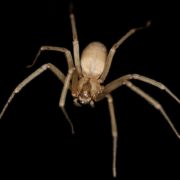Brown Recluse Spider – Fact & Fiction
It’s hard to think of a critter that inspires as much hysteria as the brown recluse spider. If you believe the tales, these small arachnids are biting people all day, every day, producing huge craters around the bite that require months of intensive care.
Although there is some truth in the hype, it is greatly exaggerated. Brown recluses do not lay in wait to bite you. However, a spider that is potentially harmful, moves erratically, unpredictably, and sometimes quickly, is easy to fear. Especially when the misinformation, misdiagnosis, and gross internet photos of bite wounds feed the fear. So let’s sort out the fact from fiction.
Location
The brown recluse only lives in a few states. Arkansas and Missouri have the highest populations, while Kansas, Oklahoma, the western portions of Tennessee and Kentucky, the southern parts of Indiana and Illinois, and the northeastern parts of Texas round out the recluse’s range.
Behavior
Brown recluses are nocturnal and shy away from daylight. They mainly live in the walls and attics of homes, and are rarely seen by humans. They do tend to enter living areas during periods of extreme temperatures – heat in August or cold in January – and may be seen in dark areas such as closets and cabinets.
Bites
Most bites occur when people roll over on the spiders in the night, put on a jacket that has been in storage, or put their foot in a shoe with a spider in it. Biting is a response to being crushed, but they’d much rather run away. In fact, the spiders’ fangs are too short and small to bite through pajamas or socks, and really only sturdy enough to puncture thin skin.
Brown recluse bites can be bad. Some of the spider’s venomous bites lead to necrotic skin lesions(thedeath of skin cells or tissue in a localized area of the body), but only around 10 percent of bites are this serious. Most bites are not that bad. They look like little pimples or mosquito bites or something else that doesn’t merit a trip to the emergency room, and they heal by themselves.
There are some ways in which brown recluse bites are different from many other wounds. A raised, reddish, and wet wound is likely not a recluse bite. Recluse venom destroys small blood vessels and causes them to constrict, turning the area around the bite white, purple, or blue. Fluids can’t flow to the area, and it sinks a little, and dries out.
Misdiagnosis
Unfortunately, the brown recluse bite diagnosis is a popular catch-all for situations where the cause of a skin lesion can’t be easily identified. There are about 40 conditions that are often misdiagnosed as brown recluse bites, including bacterial, viral, and fungal infections; poison oak and poison ivy; thermal and chemical burns; bad reactions to blood thinners, and herpes. Most physicians don’t have a lot of experience discriminating between a recluse bite and something like necrotizing Staphylococcus, and even if a patient brings in a spider for identification, it’s unlikely the ER doctor has been trained to identify a brown recluse.
Mistaken identity
Part of the problem is that the brown recluse is small and brown and about the size of a quarter; it looks like many other arachnids and insects. The best way to identify a brown recluse is to count its eyes. They have six eyes instead of eight, arranged in three pairs of two. However, most people are not going to get in a spider’s face with a magnifying glass and count its eyes.
Some people may try to find the marking most commonly described as identifying a brown recluse: a violin shape on the spider’s head, oriented with the violin’s neck pointing toward the spider’s butt. However, people are incredibly good at “seeing” violin markings on every portion of a spider’s body, which means this marking isn’t an especially helpful diagnostic.
If you suspect you’ve been bitten by a brown recluse spider, contact your primary care physician for treatment.
We can help
While brown recluse spiders aren’t as scary as people think, they are still an unwelcome houseguest. No matter how intimidating or pervasive your pest infestation, you can trust that Amco Ranger knows exactly how to handle it and make sure it doesn’t happen again. Give us a call today if you need helping getting rid of brown recluse spiders.
Have a spider issue? Check out our pest control options for your home or our blog about brown recluse prevention.





